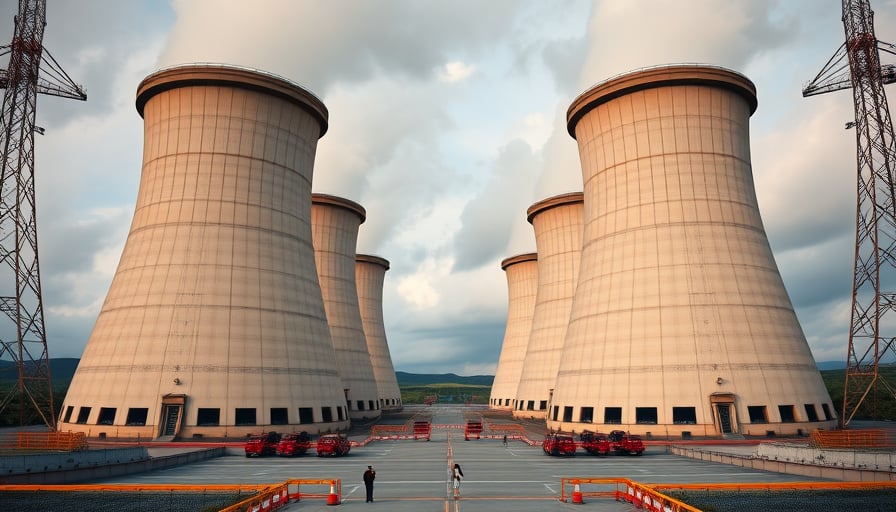Corporate Analysis: Alfa Laval’s Stock Surge Amid Early‑Stage Nuclear Project Discussions
Executive Summary
Alfa Laval’s shares have surged after reports of preliminary talks with Rolls‑Royce concerning a prospective nuclear power venture. While the market has responded positively—boosting the company’s valuation and prompting several analysts to maintain overweight recommendations—Barclays has trimmed its price target to SEK 470, reflecting a more measured view. This article dissects the underlying business fundamentals, regulatory backdrop, and competitive dynamics that may shape Alfa Laval’s potential exposure to the nuclear sector, highlighting both overlooked opportunities and substantive risks.
1. Corporate Profile and Current Position
| Metric | Value |
|---|---|
| Market Cap (Feb 2025) | SEK 1.8 bn |
| Revenue (FY 2024) | SEK 2.5 bn |
| EBITDA Margin | 18.7 % |
| Net Debt / EBITDA | 1.1× |
| Core Segments | Heat transfer, separation, power, process engineering |
Alfa Laval is a specialist in thermodynamic equipment and process solutions, with a diversified portfolio spanning oil & gas, food & beverage, and power generation. Its historical performance shows steady growth, driven largely by long‑term contracts and a robust aftermarket service model.
The company’s balance sheet is lean, and cash‑flow generation is strong, providing the financial flexibility necessary to pursue large‑scale industrial projects. However, the firm has historically concentrated on fossil‑fuel‑based power, and a pivot to nuclear would represent a strategic shift.
2. The Nuclear Opportunity: A Deep Dive
2.1 Project Scope and Technical Fit
The reported discussions involve Rolls‑Royce, a long‑time partner in marine and aerospace power systems, exploring the integration of advanced reactor components. Alfa Laval’s expertise in high‑temperature heat exchangers and pressure vessels aligns closely with the thermal and mechanical demands of next‑generation nuclear reactors (e.g., small modular reactors, advanced heavy‑water reactors).
Key technical synergies:
- Heat Transfer Equipment: Alfa Laval’s shell‑and‑tube and plate heat exchangers are already used in high‑temperature industrial processes, suggesting a smooth technology transfer path.
- Pressure Vessel Fabrication: The company’s reputation for precision in pressure‑vessel construction could be leveraged for reactor containment and fuel‑assembly housings.
- Process Optimization Software: Existing digital platforms for plant monitoring could be adapted to nuclear safety and compliance requirements.
2.2 Market Potential and Revenue Impact
Industry forecasts project the global nuclear power market to grow at a CAGR of 4.1 % through 2035, driven largely by small modular reactors (SMRs) and extended operation of existing reactors. If Alfa Laval secures even a modest 5 % of the SMR market share, estimated annual revenue would exceed SEK 300 m.
However, the nuclear market is highly capital‑intensive and subject to extended development timelines. The initial capital expenditure (CAPEX) for SMR components can run into the billions, potentially diluting early revenue streams.
2.3 Regulatory Landscape
- Licensing: Nuclear projects in Sweden and the European Union require multi‑tiered approvals (national nuclear safety authorities, European Commission, and local municipalities). The approval timeline can span 5–10 years.
- Safety Standards: Compliance with the International Atomic Energy Agency (IAEA) guidelines and European Union nuclear safety directives is mandatory. Alfa Laval would need to invest in certifications (e.g., IEC 62347 series) and establish a dedicated nuclear quality assurance program.
- Environmental Impact: While nuclear offers low CO₂ emissions, public perception and environmental scrutiny remain intense. Any environmental incident could result in significant reputational damage.
3. Competitive Dynamics
| Competitor | Core Strength | Market Share (nuclear) |
|---|---|---|
| GE Hitachi Nuclear Energy | Integrated plant design | ~25 % |
| Westinghouse Electric | Fuel fabrication and services | ~15 % |
| Mitsubishi Power | Advanced reactor systems | ~10 % |
| Alfa Laval (potential) | Modular heat exchangers & vessels | TBD |
Alfa Laval’s main competitors possess established nuclear portfolios and long‑standing government contracts. The company would need to differentiate through cost efficiency, modularity, and digital integration. Its existing relationships in the energy sector could serve as a bridge to secure pilot projects.
4. Risk Assessment
| Risk | Likelihood | Impact | Mitigation |
|---|---|---|---|
| Regulatory delay | High | High | Early engagement with authorities; hire nuclear regulatory specialists |
| Technical non‑compliance | Medium | High | Invest in dedicated R&D; partner with established nuclear engineering firms |
| Capital constraint | Medium | Medium | Leverage debt‑free cash flow; consider joint ventures |
| Reputational risk from nuclear incidents | Low | High | Develop crisis management protocols; maintain robust safety culture |
| Market volatility | High | Medium | Diversify portfolio; retain core industrial segments |
5. Investor Sentiment and Market Reaction
Alfa Laval’s share price rose 9 % on the announcement day, reflecting investor enthusiasm. Analysts at several boutique houses reiterated overweight ratings, citing potential upside. Barclays, however, revised its target downward, citing a more cautious assessment of the project’s likelihood and the high regulatory friction inherent in nuclear projects.
Key takeaways:
- Positive Catalysts: Early‑stage engagement with a high‑profile partner; alignment of core competencies with nuclear needs; potential for significant revenue upside.
- Cautionary Flags: Lack of a concrete contract; lengthy regulatory timeline; high CAPEX requirements; competition from entrenched players.
- Opportunity for Early‑Stage Bets: Firms with flexible manufacturing and modular designs may capture early SMR projects, especially in emerging markets where nuclear is being re‑examined for decarbonization.
6. Conclusion
While Alfa Laval’s foray into the nuclear sector is still in a nascent phase, the strategic alignment between its product suite and the emerging SMR market creates a plausible growth narrative. Investors should weigh the optimistic upside against the substantial regulatory, technical, and financial uncertainties. A disciplined, risk‑adjusted approach—monitoring regulatory milestones, partnership progress, and capital deployment—will be essential to discern whether Alfa Laval can translate this exploratory engagement into a sustainable revenue stream.
